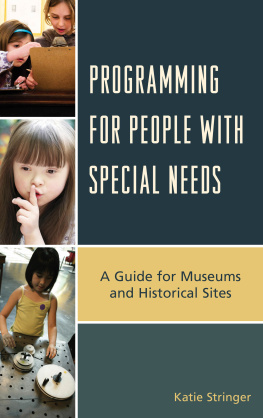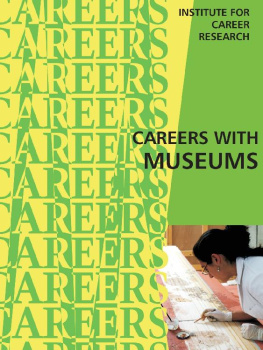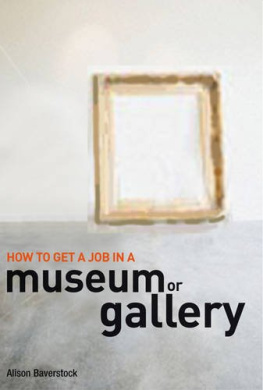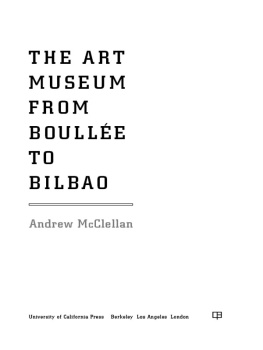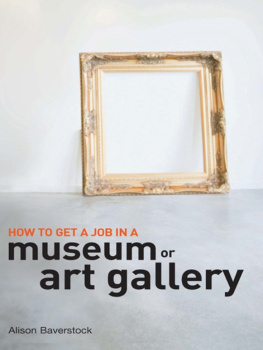MUSEUM CAREERS
A Practical Guide for Students and Novices
DEDICATED TO ALL THE Y'S AND S'S IN MY LIFE AND ESPECIALLY LITTLE MISS M.
Museum Careers
A Practical Guide for Students and Novices
N. Elizabeth Schlatter
First published 2008 by Left Coast Press, Inc.
Published 2016 by Routledge
2 Park Square, Milton Park, Abingdon, Oxon OX14 4RN
711 Third Avenue, New York, NY 10017, USA
Routledge is an imprint of the Taylor & Francis Group, an informa business
Copyright 2008 Taylor & Francis
All rights reserved. No part of this book may be reprinted or reproduced or utilised in any form or by any electronic, mechanical, or other means, now known or hereafter invented, including photocopying and recording, or in any information storage or retrieval system, without permission in writing from the publishers.
Notice:
Product or corporate names may be trademarks or registered trademarks, and are used only for identification and explanation without intent to infringe.
Library of Congress Cataloging-in-Publication Data
Schlatter, N. Elizabeth.
MUSEUM CAREERS
A practical guide for novices and students / N. Elizabeth Schlatter.
p. cm.
Includes bibliographical references and index.
ISBN 978-1-59874-043-1 (hardback: alk. paper) -- ISBN
978-1-59874-044-8 (pbk.: alk. paper)
1. Museums--Vocational guidance. 2. Museums--Employees. 3. Museum
techniques--Study and teaching (Higher) I. Title.
AM7.S27 2008
069.023--dc22
2008003812
Cover Image:
Seraphim, 2005. by Tanja Softi.
Acrylic, charcoal, and chalk on handmade paper, 39 x 39 inches.
Copyright 2005 Tanja Softi.
ISBN 978-1-59874-043-1 hardcover
ISBN 978-1-59874-044-8 paperback
Special thanks for guidance and assistance from Anthony Yanez, Doug and Dale Schlatter, Mark and Lynn Schlatter, Carolynne Harris, Marlene Rothacker, Sarah Clark-Langager, Annie Elliott, Sarah Falls, Donna Joyce, Joan Maitre, Tanja Softi, Michelle Torres Carmona, Richard Waller, Bradley Wright, the anonymous reviewers, and Mitch Allen.
THANKS ALSO TO THE FOLLOWING:
Dana Baldwin
Shari Berman
Barbara Blank
Lynda Brown
Heather Campbell
Vernon S. Courtney
Noreen Cullen
Meg Eastman
Ellen Efsic
Linda Eppich
Heather Ferrell
Kerry Folan
Tad Fruits
Henley Guild
David Hershey
D. D. Hilke
Scott Hook
Matthew Houle
Chuck Howarth
Jackie Huffines
Susan Jarvis
Lauren Telchin Katz
Olivia Kohler
Adam Lerner
Eugene G. Maurakis
Juanita Moore
Jackie Mullins
Elizabeth S. G. Nicholson
Daniel Piersol
Mike Rippy
Jennifer Pace Robinson
Terrie Rouse
Scott Schweigert
Jeri Townley
Neil deGrasse Tyson
Richard Urban
Walter R. T. Witschey
Antoinette Wright
And to all of the staff and faculty of the University of Richmond Museums, Boatwright Memorial Library, Modlin Center for the Arts, and Department of Art and Art History.
Part One
Museum Work
Introduction
Why Work in a Museum?
The museum where I work owns a print by American artist John Biggers (19242001) that I visit every time I enter our collections storage area. Titled "The Midnight Hour," the print is too sensitive to light damage to display permanently. Biggers gained widespread recognition for his accomplishments as an artist and teacher and was acclaimed for his depiction of African and African American themes. What pulls me into "The Midnight Hour," however, is not just the artist's trademark patterns, rich symbols, or rhythm of his abstracted forms, but a frankly narcissistic association I have with Biggers and my museum career. As an undergraduate gallery assistant, one of the first exhibitions I ever installed was a traveling show of Biggers's artwork. To this day, I recall hanging a particularly lush and entrancing painting and thinking, "This is what I want to do. This is it."
My early inklings of interest in museum work are typical of many in the profession, because working for a museum is both an altruistic yet selfish calling, dedicated to public education and enrichment. Typically, museums require hard work from an employee and offer relatively low or modest compensation. But museum workers have careers that feed their passions and expose them to new ideas, fascinating objects, and creative, stimulating environments. Even the crankiest museum staffers, who have been toiling away at a single institution their entire adult lives, will probably acknowledge they receive some sort of pleasure by working in a museum, such as passing an astounding dinosaur fossil or a beguiling Renaissance painting every time they walk to the accounting office or finding very hip and creative toys for their grandchildren in the museum gift store.
This interest in museum work, combined with a relatively small number of available positions, has resulted in a highly competitive environment for entry-, mid-, and senior-level jobs. A 2006 survey by the American Association of Museums (AAM) found that the median number of paid full-time staff at museums is six, and 6% of the respondent museums have no paid staff at all! Job seekers need a strategy to find openings and position themselves as strong candidates in the field of their choice, such as public relations, education, or curating.
There's no one direct route to a museum job. Although this may seem frustrating, it's actually very liberating, as people from all different backgrounds with a variety of skills and knowledge can become museum employees. The traditional trajectory still applies: Get an advanced degree, get an internship, get a job. But you'll find that some people discovered the museum world after gaining experience and skills acquired in other sectors, such as editing, gardening, teaching, and managing computer systems.
The goal of this book is to help you with that strategy from start to finish. You'll learn about different types of museum jobs, what kind of education and experience they require, where to find job listings, how to apply for jobs and conduct interviews, and how to begin your museum career. You'll read quotes from museum professionals who, unless otherwise noted, were interviewed for this publication and were eager to share their advice and experience.
You will not read declarative phrases such as "There are five critical positions in a museum...." or "To get a job as a registrar you need to ..." Instead, you'll find words and phrases like "may have," "probably are," and "most agree that," because there are many paths to becoming a museum professional. In fact, there's been a debate about whether museum work is a profession in itself or if museums are staffed by people working in various professions like accounting, public relations, publishing, etc. Regardless of the path you take, the rewards of museum work will be worth the effort.
Reasons People Work in Museums
Love of Objects
If asked, many museum workers will probably cite a love of objects as a primary motivation for working in museums. Scott Schweigert, director of the Suzanne H. Arnold Art Gallery at Lebanon Valley College, Annville, Pennsylvania, chose the museum field over teaching art history full time because he was "seduced by the materiality of the objects.... I like keeping company with the results of an artist's creativity. So for me, being in a room filled with artwork held (and still holds) tremendous appeal; so much to look at, investigate, and learn."


